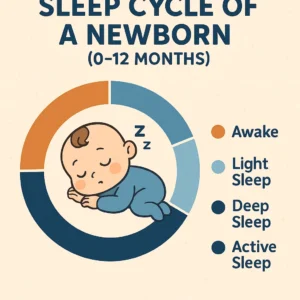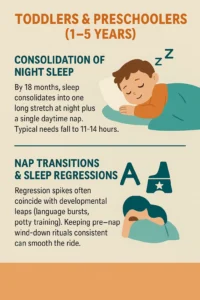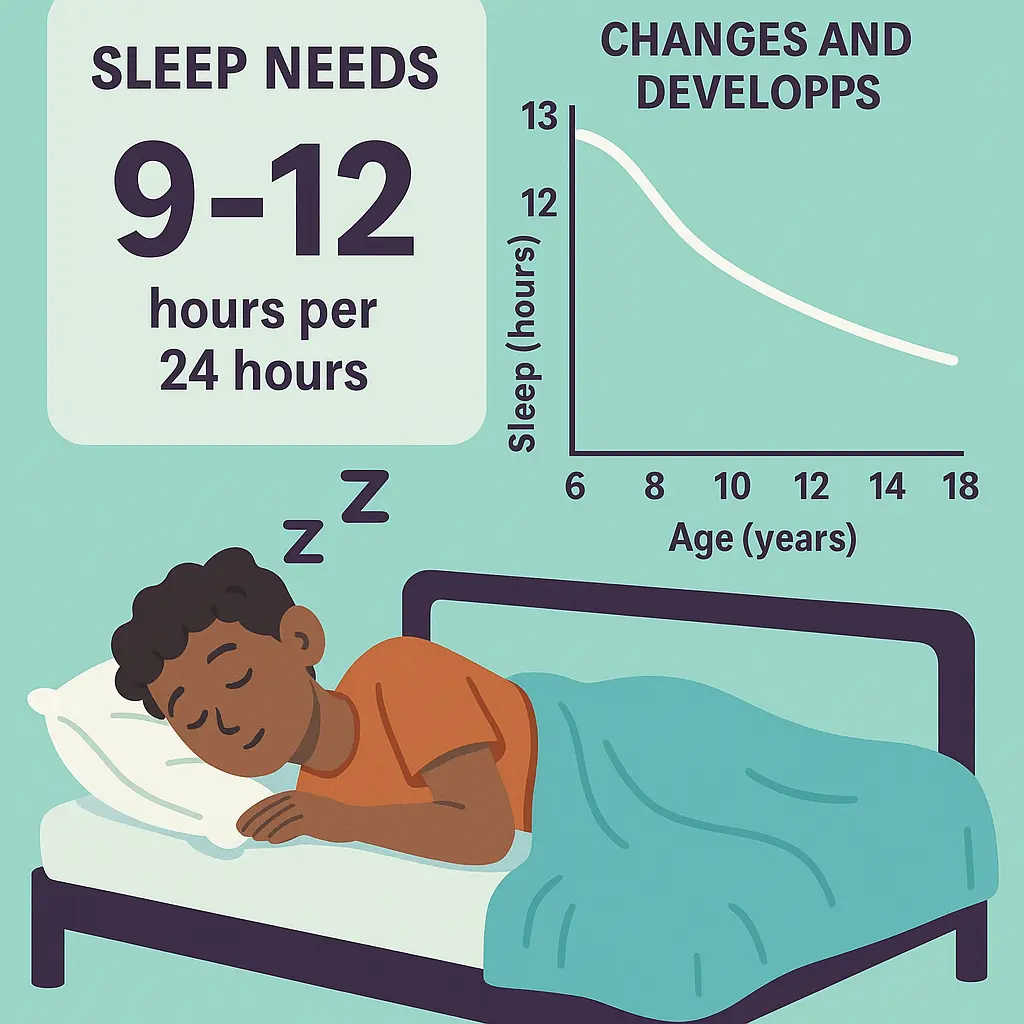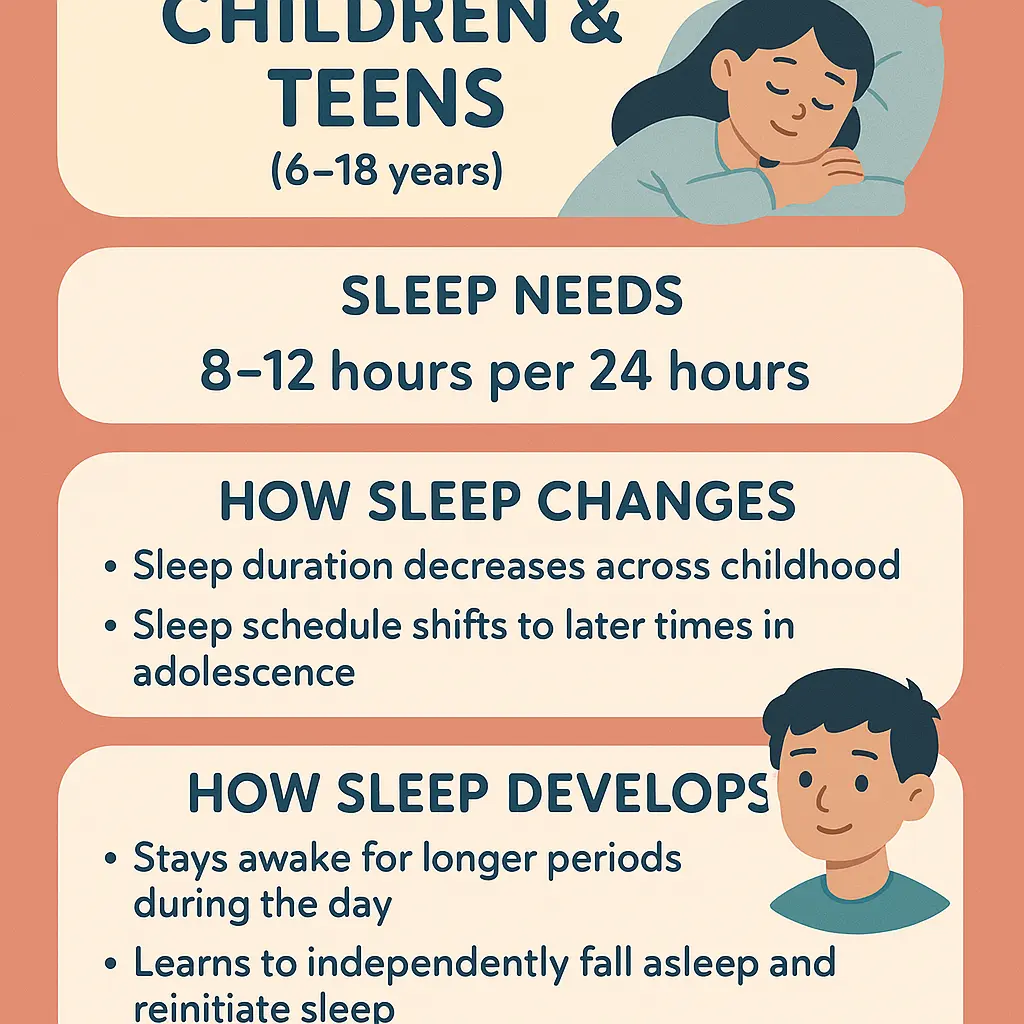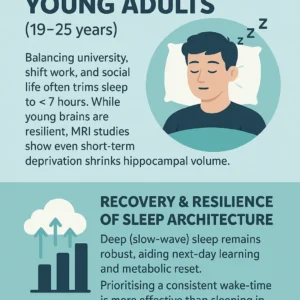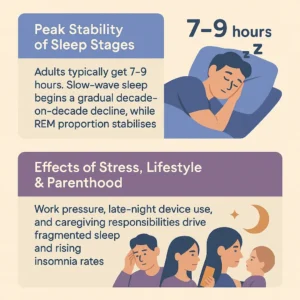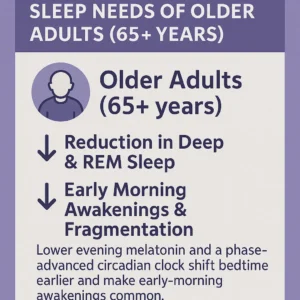Introduction
From middle‑of‑the‑night feedings to those puzzling 4 a.m. wake‑ups in our senior years, sleep is never static. Understanding why it morphs as we age is the first step to managing everything from infant regressions to adult insomnia. This guide walks you through the science behind age‑related sleep change, shows you how much shut‑eye each life stage really needs, and offers practical strategies you can start tonight.
Key Takeaway
Healthy sleep is foundational at every age: newborn brain growth, teenage learning, adult mental health, and elderly cognitive resilience all depend on getting the right amount — and right type — of sleep.
Sleep Needs by Life Stage
Newborns & Infants (0 – 12 months)
Total Sleep Time & Napping Patterns
Newborns rack up 12–16 hours of combined night sleep and daytime naps, according to the American Academy of Sleep Medicine’s consensus statement. During the first months, their short sleep bouts (≈ 2–4 hours) are regulated more by feeding cycles than circadian rhythm.
Sleep Regulation & Feeding Cycles
A newborn’s circadian clock is immature; melatonin production doesn’t surge until roughly 3 months. That’s why dim night‑time lighting and bright day‑time exposure help entrain healthy rhythms.
“Night feeds & fragmented naps”
Melissa never knew how long a night could feel until her daughter, Ella, was born. At 32, she thought she’d adjusted well to late nights during college and early mornings at work—but newborn sleep was its own universe.
Her nights blurred into a pattern of alarms that weren’t alarms at all—just Ella’s hungry cries slicing through the silence at 1 a.m., then again at 3:30. By the time the sun peaked through the curtains, Melissa felt like she’d run a marathon in place.
Daytime wasn’t much easier. Naps happened in fragments—twenty minutes here, forty minutes there—never enough for her brain to drop into deep rest. She’d close her eyes on the couch, only to be jolted awake by a tiny whimper from the bassinet.
Melissa described it as living in a fog, where her body was present but her mind floated two steps behind. And yet, in the quiet moments—rocking Ella back to sleep in the dim glow of the nursery lamp—she found an unexpected tenderness. Exhausted, yes, but also deeply present.
Sleep, she realized, wasn’t gone forever. For now, it was simply redefined.
Toddlers & Preschoolers (1 – 5 years)
Consolidation of Night Sleep
By 18 months, sleep consolidates into one long stretch at night plus a single daytime nap. Typical needs fall to 11–14 hours.
Nap Transitions & Sleep Regressions
Regression spikes often coincide with developmental leaps (language bursts, potty training). Keeping pre‑nap wind‑down rituals consistent can smooth the ride.
Common Sleep‑Training Myths
• “Skipping naps makes bedtime easier.” ✖
• “Some kids just don’t need a schedule.” ✖
• “Crying always harms attachment.” ✖
School‑Age Children & Teens (6 – 18 years)
Shift in Circadian Preference (“Night‑Owl” Tendency)
Puberty pushes the biological clock back by 2 – 3 hours, explaining the classic teen night‑owl. The National Sleep Foundation still recommends 8–10 hours — yet fewer than 1 in 3 US teens meet that target.
Impact on Learning & Behaviour
Chronic restriction worsens mood swings and reduces memory consolidation. Schools that adopt later start times report higher grades and lower absenteeism.
“Pulled‑all‑nighter exam week”
Jason, a 17-year-old high school student from Chicago, thought he had his schedule under control. Between his part-time job at a local pizza place and basketball practice, he told himself he could squeeze in study time for finals. Reality looked different.
By midnight on a Tuesday, his bedroom desk was a battlefield—textbooks stacked high, empty energy drink cans rolling near his feet. He promised himself just one more hour of review before sleep, but one turned into three, and suddenly the birds outside were louder than his phone’s alarm.
The next morning, Jason stumbled into school running on fumes. His body buzzed with caffeine and adderal, but his brain lagged like an old computer still running Windows 95. Words on the test paper blurred, and he caught himself rereading the same question over and over (poor REM sleep catching up with him, his brain never recovered). That night, he repeated the cycle, convincing himself it was the only way to keep up.
By Friday, he’d barely slept a grand total of ten hours all week. He felt irritable, forgetful, and a little empty, as if his thoughts were wrapped in cotton. Still, when his paycheck hit on Saturday, he grinned—until he realized money meant little if he was too exhausted to enjoy it.
Young Adults (19 – 25 years)
Balancing university, shift work, and social life often trims sleep to < 7 hours. While young brains are resilient, MRI studies show even short‑term deprivation shrinks hippocampal volume.
Recovery & Resilience of Sleep Architecture
Deep (slow‑wave) sleep remains robust, aiding next‑day learning and metabolic reset. Prioritising a consistent wake‑time is more effective than sleeping in on weekends.
Adults (26 – 64 years)
Peak Stability of Sleep Stages
Adults typically get 7–9 hours. Slow‑wave sleep begins a gradual decade‑on‑decade decline, while REM proportion stabilises.
Effects of Stress, Lifestyle & Parenthood
Work pressure, late‑night device use, and caregiving responsibilities drive fragmented sleep and rising insomnia rates. See our Stress & Sleep Hygiene Guide for tactical fixes.
Older Adults (65 + years)
Reduction in Deep & REM Sleep
Wearable‑based analysis of 7 million nights found deep‑sleep share falls from ~16 % in early twenties to ~13 % by early eighties (Stanford/Fullpower AI study).
Early Morning Awakenings & Fragmentation
Lower evening melatonin and a phase‑advanced circadian clock shift bedtime earlier and make early‑morning awakenings common.
[“Why Mom wakes at 4 a.m.” caregiver perspective
Carla, 45, lives in Sacramento and cares for her 78-year-old mother, Maria, who was recently diagnosed with arthritis and mild dementia. Most nights, Carla’s sleep is interrupted not by her own body clock but by her mom’s.
At 4 a.m., like clockwork, Maria shuffles down the hallway, restless and confused, searching for the bathroom or calling out her daughter’s name. Carla stirs awake instantly—half from worry, half from habit. She helps her mom back to bed, checks the blankets, and whispers soothing words until the house grows quiet again.
By then, Carla’s adrenaline is humming. Her body wants to rest, but her mind races with tomorrow’s to-do list: prescriptions to refill, a doctor’s appointment, groceries, her own full-time job. When she finally drifts back to sleep, the alarm clock seems to ring seconds later.
Carla admits she’s running on “survival mode.” Some mornings she feels like she’s moving through molasses, sharp edges smoothed away by fatigue. Yet when she sees her mom safe and calm, she tells herself it’s worth it. Still, she wonders how long her body can keep paying the price of those 4 a.m. wake-ups.]
Biological Mechanisms Behind Age‑Related Changes
Circadian Rhythm Shifts
Hormonal cascades during puberty delay the internal clock; aging pushes it forward. Light exposure acts as the master reset. Dive deeper in our Circadian Rhythm 101 guide.
Hormonal Fluctuations (Melatonin, Cortisol)
Melatonin output drops ≈ 10–15 % per decade, leading to weaker sleep drive in later life (Clinical Interventions in Aging review). Chronic stress elevates evening cortisol, sabotaging adult sleep onset.
Neurophysiological Alterations (Glymphatic Clearance)
During deep sleep, the glymphatic system flushes metabolic waste — but its efficiency erodes with age, contributing to amyloid and tau build‑up (Frontiers in Aging Neuroscience).
Common Age‑Specific Sleep Challenges
Infancy & Early Childhood: Sleep Regressions
Rapid neurological growth periodically “reboots” sleep patterns. Maintaining a predictable bedtime routine and offering steady daytime light cues helps re‑stabilise.
Adolescence: Delayed Sleep‑Wake Phase Disorder (DSWPD)
Up to 16 % of teens meet clinical criteria for DSWPD, often co‑occurring with depressive symptoms (Frontiers in Sleep, 2025). Strategic morning bright‑light therapy and evening melatonin (~0.5 mg) are first‑line treatments.
Midlife: Insomnia & Stress‑Related Disruptions
Racing thoughts, hormonal shifts, and screen overuse fuel difficulty falling or staying asleep. Cognitive‑behavioural therapy for insomnia (CBT‑I) remains gold standard — see our Adult Insomnia Toolkit.
Senior Years: Sleep‑Related Breathing & Movement Disorders
Obstructive Sleep Apnea affects ~36 % of adults 65 + (systematic review, 2023). Restless‑Legs and REM‑Sleep Behaviour Disorder also rise, sometimes heralding neurodegenerative disease.
Tailoring Sleep Strategies for Each Age Group
| Age Group | Quick‑Start Strategies |
|---|---|
| Infants & Toddlers | • Consistent bedtime routine (bath → book → bed) • White‑noise for soothing & masking household sounds • Daylight + tummy time to strengthen circadian cues |
| School Kids & Teens | • 30‑min pre‑bed tech curfew • Morning outdoor light within 30 min of waking • Advocate for later school start times where possible |
| Adults | • 10‑min evening journal to off‑load worries • Limit caffeine after 2 p.m. • Regular exercise, but finish vigorous workouts ≥3 h before bed |
| Older Adults | • Light therapy box at 7 a.m. for 20 min • Low‑dose timed melatonin (consult doctor) • Gentle mobility/stretching routine to ease nocturnal cramps |
Monitoring & Assessing Sleep Across Ages
Parental Sleep Diaries: Track nap length, bedtime, wake‑ups.
Apps & Wearables: Validate teenage/adult sleep length; note trends rather than single‑night blips.
Clinical Evaluations: Seek professional assessment if snoring, witnessed apneas, or persistent fatigue occur despite healthy habits.
Frequently Asked Questions
Do older adults really need less sleep?
Biological need stays near 7–8 hours; shorter sleep is usually the result of lighter, fragmented sleep — not a reduced requirement.
Can teens “catch up” on weekends?
Sleeping in recovers some lost slow‑wave sleep, but won’t fully reverse weekday deficits and can further delay the body clock.
Why do infants have regressions?
Developmental milestones (rolling, crawling, language spurts) temporarily disrupt brain‑sleep balance.
How do I juggle multiple age groups?
Staggered bedtimes, shared wind‑down rituals, and blackout curtains keep household sleep harmony.
Further Resources & Related Guides
- Circadian Rhythm 101
- Pediatric Sleep Training
- Adolescent Sleep Health
- Adult Insomnia Toolkit
- Healthy Aging Sleep Tips
Final Thought
No matter your age, the basics still rule: keep a consistent schedule, embrace daylight, and protect the hour before bed. Age may bend our sleep, but smart habits help it rebound.
